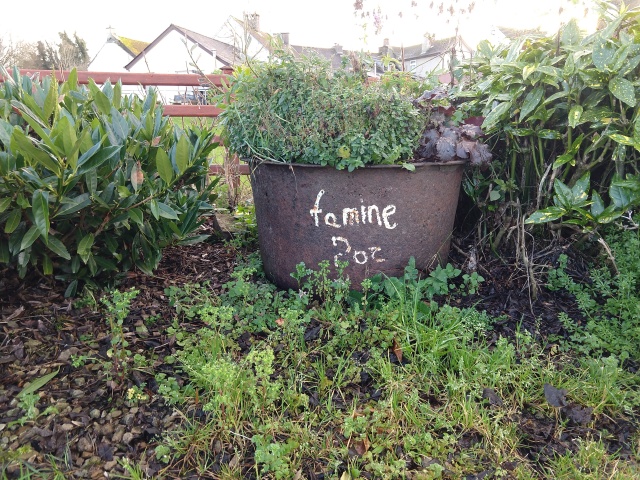
Even when the house is warm, if it’s cold outside The Gaffer likes to wrap himself up in his bed – until I suggest we go for a walk around town in search of Thursday Doors.

“What was that you said? A walk?” He loves his walks and we’re convinced he can now spell the word because even when we say the letter ‘W’ he will run to the door excitedly. Sorry for the blurred image but he moved so fast I barely got the shot.

This is the door I had in mind, a green one. The white-washed walls look to be quite old or maybe they were built to appear that way but I found houses there on the ordinance survey map of 1840. You are looking at the rear of a house that’s been renovated and I have a feeling there was an old cottage there originally and this is what’s left of it. It’s facing the river and has a lovely view from the garden. Can you make out the word ‘famine’ on the bottom right-hand corner of the photo? It’s written on a large black pot.

I wonder if that pot was found in this particular garden and if the little cottage has any connection to it.
A more apt name of what many call the Irish Famine or Potato Famine is An Gorta Mór (The Great Hunger) because there was an abundance of food at the time when blight struck the staple diet of the majority of Irish people – the potato. However, most of the food was exported and any cereal the starving tenants grew had to be used to pay their rents or they would be evicted. During the second year of The Great Hunger, in the winter of 1846, the Quakers provided 294 big cauldrons, which would later become known as famine pots, to set up the first soup kitchens. The British government followed the Quaker example in setting up soup kitchens and supplied 600 pots. Even the Sultan of Turkey donated some pots. In Dublin city a high-profile French chef, Alex Soyer, set up a model soup kitchen where his recipes were supposed to provide sufficient nutritional value for those in dire need.*
These pots are sad but necessary reminders of very dark days in Ireland’s history. They also bring to mind that even with our modern era of food production and all of its technological advances, we still have millions of people starving in our world today. The United Nations Food and Agriculture Organization estimated that about 815 million people of the 7.6 billion in the world, or 10.7%, were suffering from chronic undernourishment in 2016.
To finish on a happier note, here’s a photo of The Gaffer ignoring the very friendly geese down by the river. Next time we go, I’ll bring them some lettuce.

If you’d like to see a great selection of Thursday Doors from around the world, have a look at Norm’s blog, there’s a blue ‘frog’ button at the end of his post that will lead you there. Thanks so much for stopping by.
This link will bring you to a very interesting quick read about Famine Pots.*


Isn’t it amazing how they learn to spell? We are beyond words, beyond letters and almost beyond “that thing she wants to do” as that will now get her to cock her head and give us that look. That house has a lot of angles.
LikeLiked by 2 people
They are very quick at picking up sign language, too, Dan.
LikeLiked by 1 person
Ha ha!
LikeLiked by 1 person
Around here pet owner friends will switch to French or English depending on which is not the regular household language. This just means that with time and practice most cats and dogs end up being bilingual 😀
LikeLiked by 4 people
Ha ha – that’s amazing.
LikeLiked by 2 people
Our dog was a rescue we brought back from Spain, so he’s probably bilingual. Hmm, maybe we should start speaking Irish around him. I’ll have to brush up on my Gaelge
LikeLiked by 1 person
Yes, I can see that the part with the green door is probably older than the rest of this house. Looked up your link of the famine pots. A food famine is gut wrenching:(
Learned another part of Ireland’s history, and the Quakers Didn’t know that they were in Ireland, since I knew it as predominantly Catholic – but what outsiders know as a countries’ history may be a skewed view! Now I’m curious why the Turkish sultan was so invested on helping, even secretly, in helping Ireland!
LikeLiked by 1 person
The sultan also sent five ships filled with food and goods to be distributed to the poor and they were refused docking at Dublin port so they sailed on to Drogheda and the cargo was disembarked there. There’s a plaque commemorating it in the town.
LikeLiked by 1 person
Wow, it sounds like the plot of a book or movie – what an incredible generosity:)
LikeLiked by 1 person
James Joyce referred to the sultan’s generosity in Ulysses. So you are spot on with your comment, Jesh. Also, there’s been a movie planned about this for the past few years, a fictional love story of an Irish girl and one of the Turkish sailors. Was supposed to be released in 2017 but no news of late about it. I’ll let you know if it ever comes out.
LikeLike
Thank you, Jean! Would like to see that movie!
LikeLiked by 1 person
Fascinating! It’s always good to remember that we take our food supply for granted. Tomorrow is guaranteed to no one.
LikeLiked by 2 people
I totally agree, Jan
LikeLike
Wonderful thought-provoking post Jean. One of the most disheartening stats from those UN food reports is when you start looking at the percentage of food that ends up being wasted. And we Canadians are among the most wasteful in the world 😦
LikeLiked by 2 people
That’s true, so much is wasted every day, here in Ireland, too. We have refuse collectors who call specifically to take away leftovers, spoiled food and peelings for recycling. At least it’s put to some use, I suppose, but they would go out of business in less affluent countries.
LikeLiked by 2 people
Another wonderful, informative post, Jean. Thank you for the background to the Famine Pots – I did know a lot about the Potato Famine, aggravated by the dreadful attitude of the English Parliament of the time… Gaffar looks great fun – I’m impressed by his indifference to the geese:)
LikeLiked by 2 people
I’ve never let him off the lead around them, Sarah, but I think he knows they can be quite fierce when provoked.
LikeLiked by 1 person
Oh yes – they are terrifying, aren’t they? The Romans used to use geese to guard their properties…
LikeLiked by 1 person
Pingback: Thursday Doors | homethoughtsfromabroad626
We had a cat that would bury himself in blankets, towels, whatever he could find.
The story of famine pots is new to me. Toronto took in many of the famine immigrants. A sad piece of history. Even though I was born in Dublin there were never any stories of the famine passed down from my grand or great-grandparents and I always thought that was odd.
LikeLiked by 2 people
Those generations wanted to forget, Jackie, and who could blame them. My mother knew her great grandmother well as she lived to be 102 (Mum was twelve when she died) and she was a child in the Great Hunger but never spoke about it or what the family went through.
LikeLike
Wow, really interesting post! I wonder how many of those pots still exist?
LikeLiked by 2 people
There are hundreds of them all over the country. The link in the post is to a website that is trying to locate them all, to record and preserve them.
LikeLike
Interesting information on famine pots!
LikeLiked by 1 person
Thank you.
LikeLike
Pingback: Sunday Post – 27th January, 2019 #Brainfluffbookblog #SundayPost | Brainfluff
Well I never tire of photos of the Gaffer 🙂 What a good boy!
It was a sad middle, but it’s good to educate and inform and we appreciate it.
LikeLiked by 1 person
Thanks,, Joey. He really is a great little dog, we love him to bits.
LikeLike
Sounds like those pots are becoming collectible after reading your link. Good to preserve the past in my opinion.
LikeLiked by 1 person
They keep discovering more of them each year.
LikeLiked by 1 person
That’s a good thing 😊
LikeLiked by 1 person
A very interesting and informative post. It is good to be reminded there remain many who don’t have enough to eat, a truly sad situation. The Gaffer is adorable, and quite smart too!
LikeLiked by 1 person
He outsmarts us at times, Brenda.
LikeLiked by 1 person